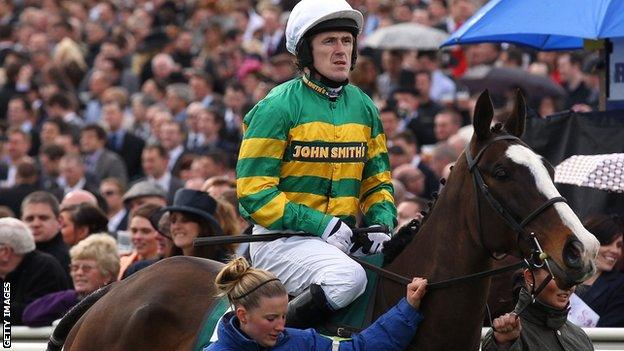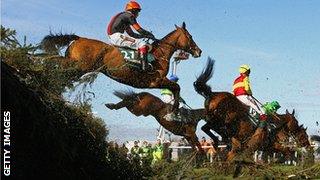Grand National: Plotting the best course to safer racing
- Published

Jockey AP McCoy rode Synchronised in Saturday's Grand National
Calls for changes to the Grand National at Aintree have been made after two horses died in Saturday's four-and-a-half-mile race.
There have been 20 equine fatalities from a total of 840 runners in the last 22 races since the course was remodelled in 1990.
Here we talk to three former National jockeys and other figures involved with horse racing as we look at some of the issues that now face the famous 30-fence contest.
Deaths of horses
The casualty rate in the National is much higher than other steeplechases, where an average of four in every thousand horses die.
But British Horseracing Authority (BHA) chief executive Paul Bittar said changes and safety improvements at Aintree had already led to a reduction in deaths.
"The decade since 2000 was the safest on record for the Grand National, with a fatality rate of 1.5%, compared with 3.3% at the start of the 1990s," he said.
Ten horses died during nine Grand Nationals in the 1990s (the 1993 race was void), whereas six lost their lives in the 10 years from 2000. But safety concerns have come to the fore again after two horses died in both of the last two races.
Carl Llewellyn, who rode Party Politics (1992) and Earth Summit (1998) to victory in the race, said those associated with the horses would be deeply saddened.
"The people it affects are the owners, the trainers, the jockeys and the stable staff who look after these horses every day," he said.
"It is a sport and it involves animals. They are in the best physical and mental shape. They have the best food, best veterinary attention. They have massages, the best blacksmiths, the best hay.
"They are kept in fantastic condition, and sadly sometimes they pay with their lives. It hurts us a lot more than it hurts people sitting at home on the couch saying it's a cruel sport."
However, the RSPCA animal charity says deaths in the National are unacceptable.
"The race cannot continue in its present form unless the issues raised this year are addressed," said its equine consultant David Muir.
What has been done already?
After the deaths of Ornais and Dooneys Gate in last year's race,, external Aintree introduced a series of measures following a thorough review that included consultation with animal welfare groups, jockeys and trainers.
The fourth fence was dropped two inches in height to 4ft 10in, the landing side of the first obstacle was levelled off and the drop from the iconic Becher's Brook (sixth and 22nd) reduced.
Other measures included raising entry requirements and introducing new cooling-down areas for horses.
Mick Fitzgerald, winner of the 1996 race on Rough Quest, said some well-meaning changes could prove counter-productive however.
Reducing the fearsome drop on the landing area at Becher's Brook meant many riders felt more comfortable taking a previously more dangerous inside route.
"I spoke to one of the jockeys in the race and he said because they have levelled off the landing side of Becher's, not many jockeys went wide and it was quite congested jumping it," he said.
The two horses who died - Cheltenham Gold Cup winner Synchronised and According To Pete - were both casualties at Becher's.
Synchronised fell there first time round and then continued riderless before fracturing a leg further down the course, while According To Pete was brought down when another horse fell in front of him on the second circuit.
"What should not happen is a knee-jerk reaction. They have to gather all the information they can, sit down with the relevant parties and make decisions as a group for the right reasons," said Fitzgerald.
"The Grand National is one of our national institutions and I hope that stays the case, but anything they can do to make the sport safer for everyone has got to be a good thing."
Field size
A reduction in the number of runners from a maximum of 40 is "paramount", according to former jockey Richard Pitman.
Neptune Collonges wins Grand National - race in full
"If you lowered the field to 25, that course is so wide, there wouldn't be such a mad rush to the start," said Pitman, who was runner-up to Red Rum on Crisp in the 1973 National.
"By the first 11 fences, 16 horses were out of the race on Saturday. Fewer horses means more room. The fences are perfectly jumpable, but if you reduce the field by 15 runners everyone has a clear view of them."
The start
Two false starts as jockeys broke the tape heightened anticipation before the race began and all 40 runners charged to the first fence.
"I would like to see a fence quite close to the start as there is such a long way to go to the first," said Pitman.
"It's such a big adrenaline rush, that's the trouble. You've got to bring the jockeys' minds sharply into focus and give everyone who causes a false start a heavy fine."
Research before this year's race showed 53% of falls happened in the first one minute and 35 seconds of the race, which takes an average of about nine and a half minutes to complete.
On Saturday, Synchronised unseated jockey AP McCoy and got loose before the start, which caused an eight-minute delay before he was cleared to race by vets.
Roly Owers, chief executive of the World Horse Welfare charity, said he had no dispute with the horse being allowed to run despite expending energy before the race.
"He's a fit horse and if there had been any doubt in the vet's mind, he would have been stopped," said Owers.
The fences
The iconic Becher's Brook and other "drop fences" should be replaced, said RSPCA equine consultant Muir.

Aintree's Becher's Brook fence features a famously steep drop
"The fence has taken the lives of too many horses to remain in existence," he said.
He said horses landed on ground that was considerably lower than where they began their jump, and tended to land with a lot of weight on the front half of their body.
"We have to find a way of having the race, but not one that produces few finishers," added Muir.
But simply making some fences smaller is not necessarily the answer.
"If you choose to lower the height of fences, it can mean horses go faster and increase the risk," said Professor Tim Morris, the BHA's director of equine science and welfare.
What happens next?
Aintree managing director Julian Thick said everything that happened on Saturday would be reviewed in detail.
"The course has been in a constant state of evolution since the race was first run [in 1839]. If we deem it necessary to change for the safety of horses, we won't stand still," he said.
He pointed out that four other races over the National fences since safety improvements were made had passed without serious incident.
Professor Morris added: "This is a unique race and it makes statistics very difficult to interpret.
"We have to use expert opinion and make informed judgements. We need a measured response."
- Published15 April 2012
- Published14 April 2012
- Published15 April 2012
- Published14 April 2012
- Published14 April 2012
- Published14 April 2012
- Published14 April 2012
- Published14 April 2012
- Published14 April 2012
- Published14 April 2012
- Published14 April 2012